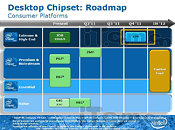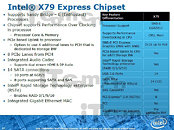- Joined
- Oct 9, 2007
- Messages
- 47,533 (7.47/day)
- Location
- Hyderabad, India
| System Name | RBMK-1000 |
|---|---|
| Processor | AMD Ryzen 7 5700G |
| Motherboard | ASUS ROG Strix B450-E Gaming |
| Cooling | DeepCool Gammax L240 V2 |
| Memory | 2x 8GB G.Skill Sniper X |
| Video Card(s) | Palit GeForce RTX 2080 SUPER GameRock |
| Storage | Western Digital Black NVMe 512GB |
| Display(s) | BenQ 1440p 60 Hz 27-inch |
| Case | Corsair Carbide 100R |
| Audio Device(s) | ASUS SupremeFX S1220A |
| Power Supply | Cooler Master MWE Gold 650W |
| Mouse | ASUS ROG Strix Impact |
| Keyboard | Gamdias Hermes E2 |
| Software | Windows 11 Pro |
Intel's next platform for enthusiasts (successor to LGA1366, X58), will consist of a 2011-pin LGA socket, the Sandy Bridge-E (enthusiast) processor that features a massive quad-channel DDR3 memory controller and 32+ lane PCI-Express 2.0 hub, and the X79 chipset. Intel is looking to skip the 6-series chipset family with its next high-end platform chipset, and perhaps it makes sense since the platform is slated for Q4 2011. The X79 is a PCH (platform controller hub), like P55 and P67, since Intel has reorganized the platform. The beefy PCI-E hub housed in the X58 northbridge is relocated to the processor die, and the southbridge is given a much needed overhaul in terms of connectivity.
The X79 is much bigger than P67 in terms of connectivity and features. Differences start right at the interconnect. While P67 connects to the processor over DMI (physical PCI-Express 2.0 x4), X79 supplements this link with an additional PCI-Express 2.0 x4 link to the processor's PCI-E hub if the user chooses so, in the EFI setup program. The chipset bus hence ends up with 8 GB/s of bandwidth, and wait till you hear what will make use of it: a 10-port SATA 6 Gb/s RAID controller integrated to the PCH! That is a huge improvement in terms of storage connectivity, which is limping with 2-port SATA 6 Gb/s (next to four 3 Gb/s ports) on 6-series chipsets.


Out of the 10 SATA 6 Gb/s ports, eight can be configured as SAS (serial-attached SCSI) by motherboard manufacturers. In RAID mode, the controller supports RAID 0/1/5/10 modes. Unfortunately, there's no talk of an integrated USB 3.0 controller, the PCH still features 14 USB 2.0 ports. Perhaps Intel is pushing Thunderbolt, but there's no evidence of that integrated with the chipset, either. The PCH itself features an 8-lane PCI-Express 2.0 hub to drive the x1, x4 slots on the motherboard and onboard PCI-E devices. It features an Intel GbE interface (physically PCI-E 2.0 x1 at 50 MHz), to drive a Lewisville gigabit Ethernet PHY chip. Lastly, X79 is geared for extreme overclocking of the processor and memory. That's expected of this platform.
View at TechPowerUp Main Site
The X79 is much bigger than P67 in terms of connectivity and features. Differences start right at the interconnect. While P67 connects to the processor over DMI (physical PCI-Express 2.0 x4), X79 supplements this link with an additional PCI-Express 2.0 x4 link to the processor's PCI-E hub if the user chooses so, in the EFI setup program. The chipset bus hence ends up with 8 GB/s of bandwidth, and wait till you hear what will make use of it: a 10-port SATA 6 Gb/s RAID controller integrated to the PCH! That is a huge improvement in terms of storage connectivity, which is limping with 2-port SATA 6 Gb/s (next to four 3 Gb/s ports) on 6-series chipsets.


Out of the 10 SATA 6 Gb/s ports, eight can be configured as SAS (serial-attached SCSI) by motherboard manufacturers. In RAID mode, the controller supports RAID 0/1/5/10 modes. Unfortunately, there's no talk of an integrated USB 3.0 controller, the PCH still features 14 USB 2.0 ports. Perhaps Intel is pushing Thunderbolt, but there's no evidence of that integrated with the chipset, either. The PCH itself features an 8-lane PCI-Express 2.0 hub to drive the x1, x4 slots on the motherboard and onboard PCI-E devices. It features an Intel GbE interface (physically PCI-E 2.0 x1 at 50 MHz), to drive a Lewisville gigabit Ethernet PHY chip. Lastly, X79 is geared for extreme overclocking of the processor and memory. That's expected of this platform.
View at TechPowerUp Main Site
Last edited:












